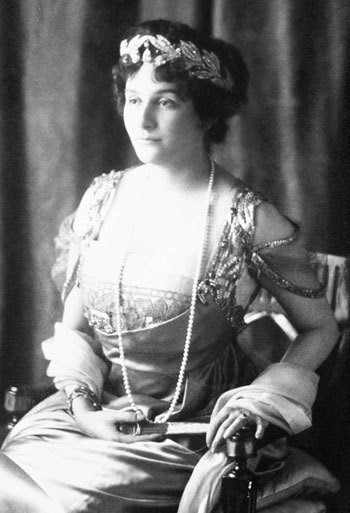 |
| (source) |
Tiara Timeline: The Leuchtenberg Sapphire Tiara
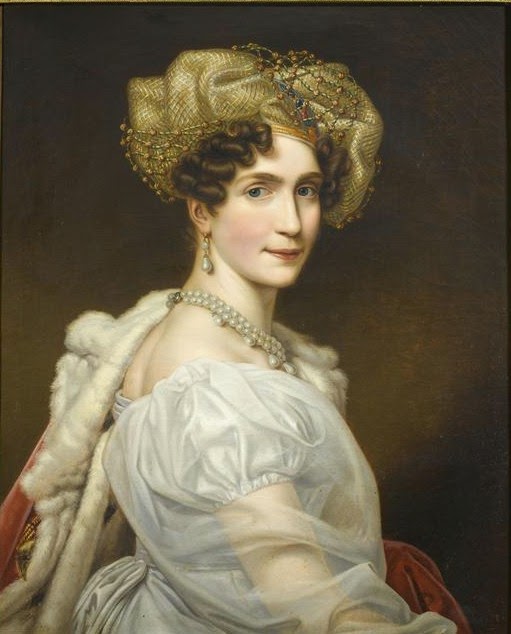 |
| (source) |
1806: On January 14 in Munich, Princess Augusta (pictured above ca. 1820), the eldest daughter of King Maximilian I Joseph of Bavaria, marries Eugène de Beauharnais. The groom is the only son of Joséphine de Beauharnais. Two days before the wedding, Eugène was officially adopted by his mother’s husband, Napoléon Bonaparte. Augusta’s father — who has only been king for two weeks — is one of Napoléon’s most important allies in Germany, a relationship reinforced by this royal marriage.
Among Princess Augusta’s wedding gifts is an elaborate diamond and sapphire parure that was almost certainly made by Marie-Étienne Nitot, the French imperial court jeweler. The most likely giver of the sapphires is Napoléon, who had engineered this marriage and within weeks would position Eugène and Augusta as heirs of the throne of Italy. The tiara, which features an elaborate diamond base topped by sapphires, is so flexibly constructed so that it lays flat in its case. The sapphires can also be interchanged with a set of upright pear-shaped pearls.
1817: With Napoléon finally deposed and exiled, it is clear that Eugène and Augusta’s future will be as a part of the extended Bavarian royal family, not as the Italian king and queen. On November 14, King Maximilian I Joseph bestows the style and title of His Royal Highness the Duke of Leuchtenberg on Eugène (pictured above). Because of this title change, the sapphires will become known to history as the Leuchtenberg sapphire parure.
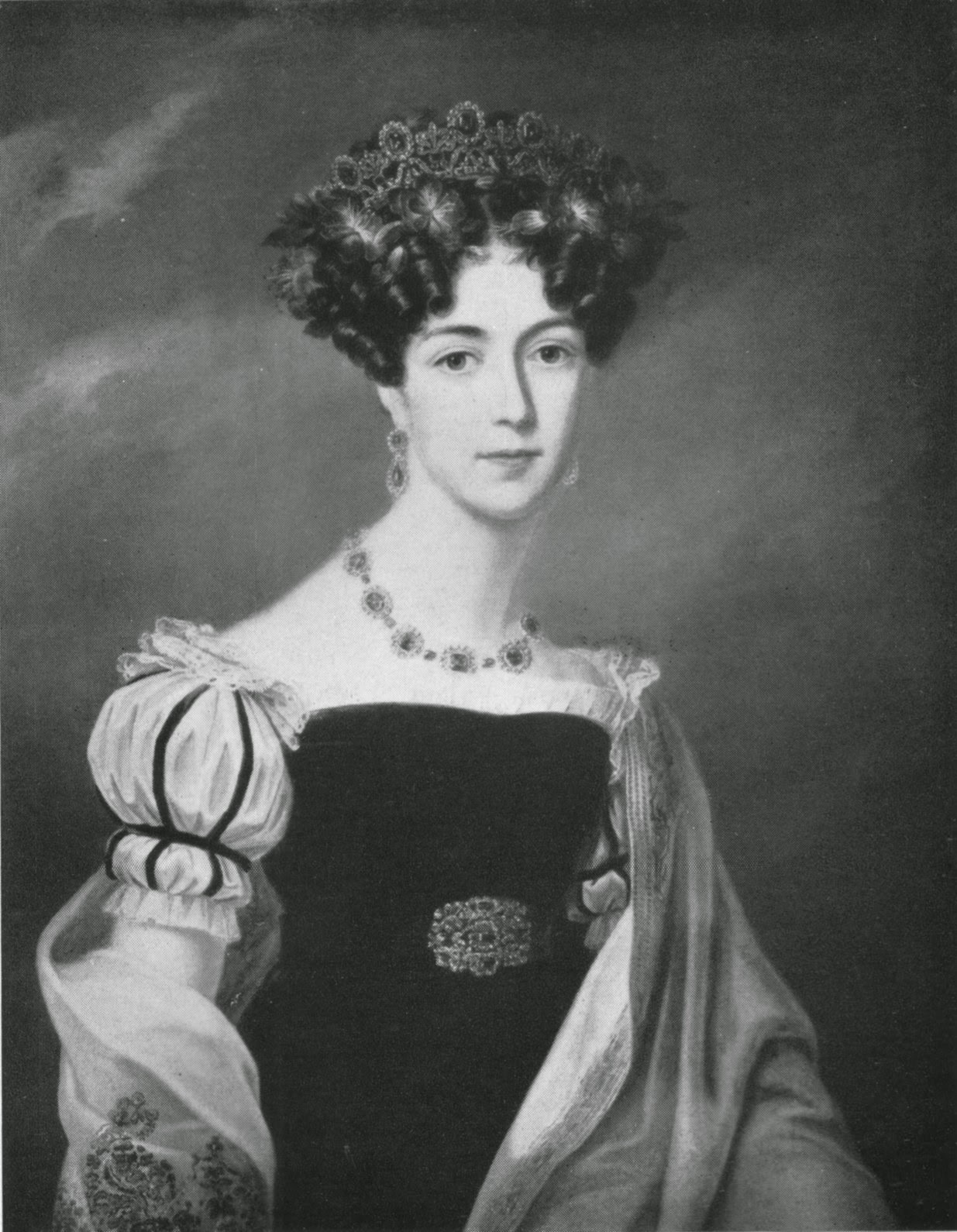 |
| (source) |
1823: Eugène and Augusta’s eldest daughter, Joséphine of Leuchtenberg, marries Crown Prince Oscar of Sweden in a proxy ceremony in Munich on May 22. Joséphine adopts the Swedish spelling of her name and becomes known as Crown Princess Josefina. Although he’s a Swedish prince, Oscar’s parents were both born in France and were both important figures at the imperial court of Napoléon. King Carl XIV Johan (born Jean-Baptiste Bernadotte) was one of the Marshals of the Empire, while Queen Desideria (born Désirée Clary) had been engaged to marry Napoléon until he met Joséphine de Beauharnais. Napoléon was one of Crown Prince Oscar’s godfathers. Above, a young Josefina is depicted wearing her mother’s sapphires around the time of her marriage.
1844: King Carl XIV Johan of Sweden dies, and Oscar and Josefina become the King Oscar I (pictured above) and Queen Josefina of Sweden and Norway.
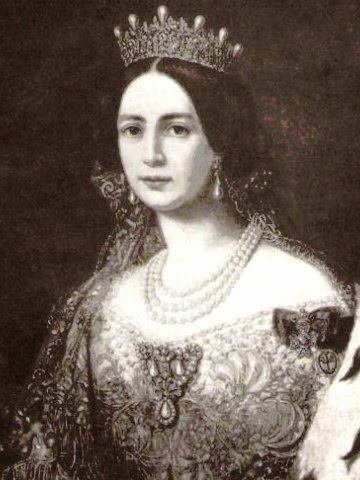
1851: The Duchess of Leuchtenberg dies in Munich. In her will, Augusta leaves the Leuchtenberg sapphires to her eldest daughter, Queen Josefina. (She leaves another important parure, her emeralds, to her second daughter, Amélie, the widow of Emperor Pedro I of Brazil.) Above, Josefina wears the tiara with the upright pearls, which have apparently since left the Bernadotte collection.
1859: King Oscar I dies in Stockholm; he is succeeded by his and Josefina’s eldest son, Carl XV (pictured above). Although she is now the Queen Dowager, Josefina does not hand over her jewels to Carl’s wife, Queen Louise. Instead, she keeps her jewelry collection, including her mother’s sapphires, largely intact.
1872: King Carl XV dies without a legitimate male heir. He is succeeded by Oscar and Josefina’s third son, who becomes King Oscar II of Sweden and Norway (pictured above). Oscar is married to Sofia of Nassau, a German princess.
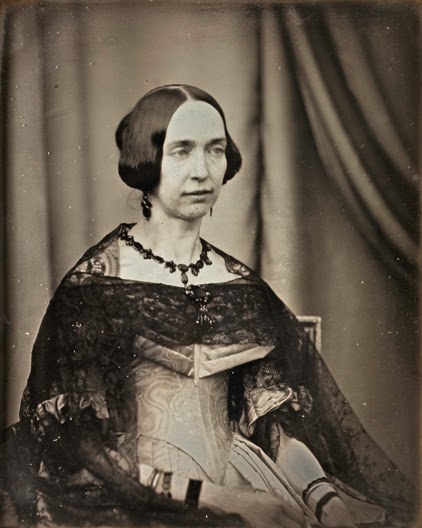 |
| (source) |
1876: Queen Josefina (pictured above around 1850) dies in Stockholm. In her will, she leaves the Leuchtenberg sapphires to her son, Oscar II.
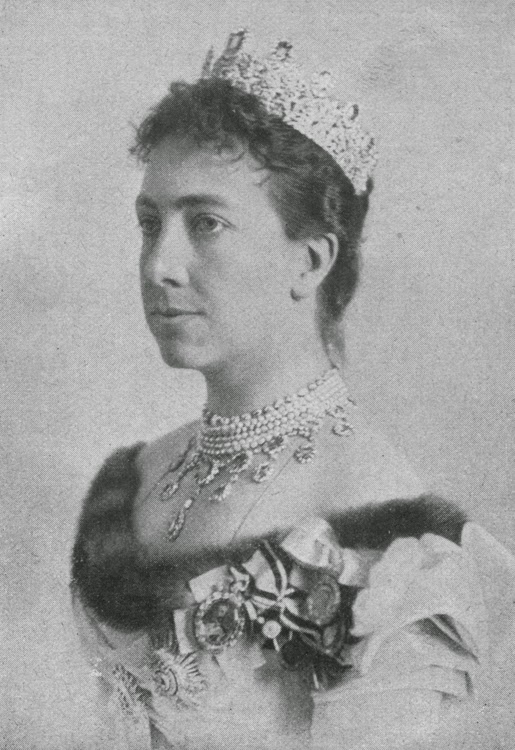 |
| (source) |
1881: Crown Prince Gustaf, Oscar and Sofia’s eldest son, marries Princess Victoria of Baden on September 20 in Germany. The Leuchtenberg sapphires become a wedding gift for the second time when Oscar and Sofia bestow the set on their new daughter-in-law. Clearly fond of the sapphires, Victoria wears the tiara in numerous official portraits during her lifetime. Above, she poses in the sapphires around 1902.
1907: King Oscar II dies, and Gustaf and Victoria become King Gustaf V and Queen Victoria of Sweden.
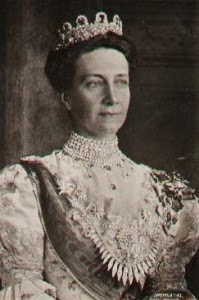 |
| (source) |
1930: Queen Victoria dies in her villa in Rome. Instead of leaving the sapphires to her daughter-in-law, Crown Princess Louise, she decides to bequeath the jewels to the Bernadotte family foundation. This decision ensures that the Leuchtenberg sapphires remain in trust in Sweden, which means that they are no longer private property and cannot leave the family. It also means that any of the royal women entitled to wear the family’s jewels can use the sapphires, though in practice, they are only used by the highest-ranking royal lady.
1938: Crown Princess Louise, wife of Crown Prince Gustaf Adolf and therefore de facto first lady of Sweden, wears the Leuchtenberg sapphires to the celebrations for the 80th birthday of her father-in-law, King Gustaf V. (She’s chatting with King Haakon VII of Norway at the birthday banquet in the photo above.) The sapphires become signature jewels for Louise, who poses in numerous portraits wearing them.
1950: In October, King Gustaf V dies, and Crown Prince Gustaf Adolf and Crown Princess Louise become King Gustaf VI Adolf and Queen Louise of Sweden.
1953: In December, Queen Louise wears the sapphires to the Nobel Prize Ceremony. (The woman sitting beside her is Clementine Churchill.)
1965: Queen Louise dies in March. The new Swedish first lady is her stepdaughter-in-law, Princess Sibylla, who wears the sapphires until her death in 1972.
1973: King Gustaf VI Adolf dies and is succeeded by his grandson, King Carl XVI Gustaf.
1976: King Carl XVI Gustaf is engaged to marry Silvia Sommerlath, a German commoner. Before the wedding, the highest-ranking Swedish royal lady is one of the king’s elder sisters, Princess Birgitta of Sweden and Hohenzollern. (Birgitta isn’t the king’s eldest sister, but she is the only one who married another royal. Until Carl XVI Gustaf’s reign, royals who married commoners lost their titles and statuses. So even though Princess Margaretha is older, by 1976 Birgitta was her senior in rank.) At the ball held the night before the royal wedding, Princess Birgitta wears the Leuchtenberg sapphires. It’s the only time she ever wears the set, as the country gains a new senior royal lady when Silvia becomes queen the following day. (At the pre-wedding ball, Silvia wears the Connaught tiara that was a favorite of the late Princess Sibylla — you can see her wearing the tiara in the picture above.)
1978: Queen Silvia of Sweden wears the sapphires at the Nobel Prize Ceremony.
1980: King Carl XVI Gustaf and Queen Silvia make a state visit to France. Silvia brings the sapphires back to their original home country and wears them during a banquet at the Palace of Versailles.
1982: Queen Silvia wears the sapphires at the Nobel Prize Ceremony. On this occasion, she demonstrates the flexibility of the tiara by wearing it in a more open form.
2001: Queen Silvia wears the sapphires at the Nobel Prize Ceremony.
2004: Queen Silvia wears the sapphires at the Nobel Prize Ceremony.
2006: Queen Silvia wears the sapphires at the Nobel Prize Ceremony.
2007: Silvia wears the sapphires at a gala dinner for the Nobel laureates.
2008: During a state visit from Luxembourg, Queen Silvia wears the sapphires at the state banquet at Drottningholm Palace in Stockholm.
2010: Silvia wears the sapphires at the Nobel Prize Ceremony.
2012: Queen Silvia wears the sapphires at the Nobel Prize Ceremony.
Saturday Sparkler: The Duchess of Alba’s Pearl Tiara
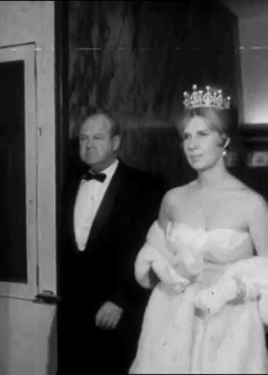 |
| Cayetana Fitz-James Stuart y Silva, 18th Duchess of Alba (GIF source) |
There are royals, there are nobles, and then there was Cayetana Fitz-James Stuart y Silva, the 18th Duchess of Alba. The duchess died this week at the grand old age of 88. During her lifetime, she might have been more famous for her appearance and her marriages, but she also had more legitimately recognized noble titles than anyone else on earth and a diamond and pearl tiara with a serious pedigree. So there!
Empress Eugénie, previous owner of the pearl tiara
Cayetana’s pearl tiara had an illustrious previous owner: Eugénie, the last Empress of France. Eugénie was born in Spain, the daughter of an aristocratic Spanish family. Her sister María Francisca married Jacobo Fitz-James Stuart, the Duke of Alba. (Can you tell that Jacobo had a significant royal connection? That surname means that he was descended from the 1st Duke of Berwick, who was the illegitimate son of James II of England and Arabella Churchill.)
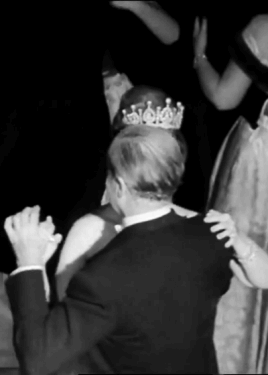 |
| Cayetana Fitz-James Stuart y Silva, 18th Duchess of Alba (GIF source) |
Jacobo and Maria Francisca were the great-grandparents of the late duchess, which means that the French empress was her great-grand-aunt. The tiara traveled through the Alba family tree from Eugénie to Cayetana, whose family still owns it today.
The Duchess of Alba dies, aged 88: http://t.co/2bsQvXWZGm pic.twitter.com/rP4yKXAGBL
— Grazia_Live (@Grazia_Live) November 20, 2014
For her first wedding in 1947 (pictured above), Cayetana chose to wear Eugénie’s tiara, which features laurel wreath motifs and alternating upright pearls and square-cut diamonds. The marriage ended with her husband’s death, but the tiara stayed with the family. In 1998, Cayetana’s daughter, Eugenia, wore her namesake’s tiara at her own wedding. That marriage ultimately failed, but I’m loath to declare such a lovely piece to be bad luck! Hopefully, the next Alba bride to sport this sparkler will prove that the third time really is a charm.
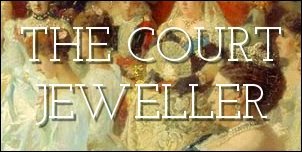
- « Previous Page
- 1
- …
- 57
- 58
- 59
- 60
- 61
- …
- 66
- Next Page »